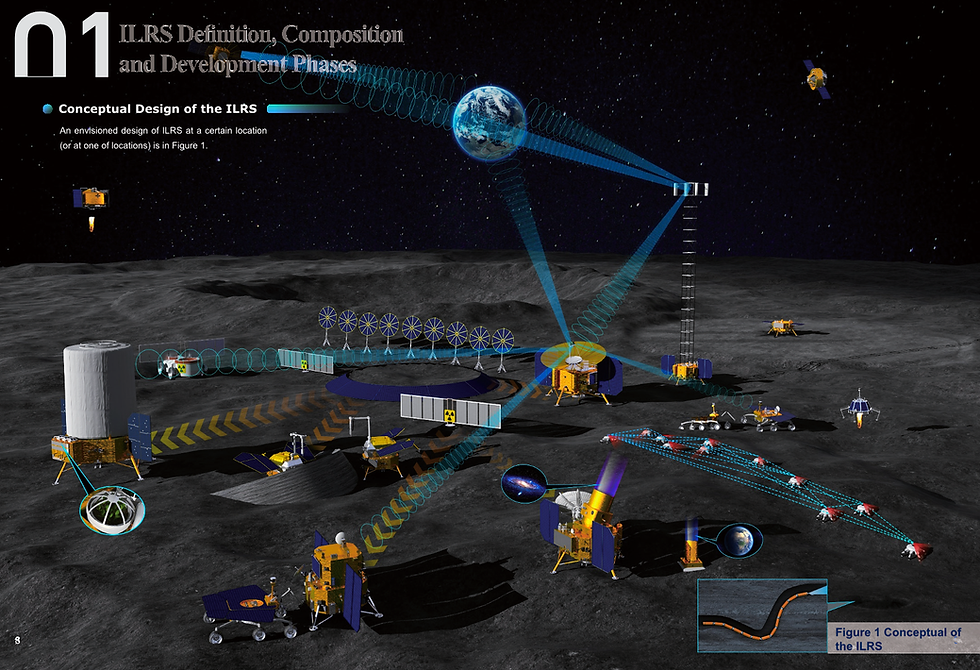By Marcus Tsai
The Lawrenceville School, NJ
The International Lunar Research Station: A New Chapter of Space Exploration
In 2021, China and Russia made an exciting announcement: they plan to team up and build the International Lunar Research Station (ILRS), a permanent research station on the Moon. This ambitious mission marks a new era of space exploration because it is another step towards learning about our solar system. By looking at what China has planned for the ILRS and comparing it to other lunar missions, such as NASA’s Artemis program, we can see that the future of lunar exploration is full of promise.
What Are China’s Plans?
The International Lunar Research Station is designed to be a long-term research base on the Moon’s south pole; a region full of ice. This is important because water could be used to make oxygen, drinking water, and even fuel for future missions that require water, oxygen, or hydrogen. The ILRS will not only study the Moon’s surface, but also focus on in-situ resource utilization (ISRU), which means using the Moon’s resources instead of being forced to bring everything they need from Earth. This could make living on the Moon more sustainable for the future.

Conceptual Design of the ILRS
China’s goal with the ILRS is to create a place for scientists to conduct experiments in areas such as lunar geology, biology, and astrology. The ILRS will also test new technologies that could help future astronauts live and work on the Moon for longer periods of time, perhaps even testing methods and technology that could help missions to Mars as well. This new technology includes developing new ways to make energy, extract resources, and build habitats. Although China and Russia are currently leading the project, there’s also potential for other countries to join in as the project develops, which could turn the ILRS into an international mission.
How Do China’s Plans Compare to Other Lunar Missions?
China’s ILRS is part of a larger trend of countries working to establish a permanent human presence on the Moon. NASA’s Artemis program, for example, is aiming to return astronauts to the Moon by 2025 and establish a long-term base there by the 2030s, a plan that is similar to China’s. While the ILRS focuses heavily on scientific research and resource use, NASA’s Artemis program has a slightly different focus. Artemis aims to not only explore the Moon, but also use it as a stepping stone for missions to Mars. The Artemis mission will use new technological developments for their future trips to Mars and might use the Moon as a middle-ground for future missions to and from the Red Planet. The Artemis program includes building a space station called the Gateway, which will orbit the Moon and help astronauts travel back and forth between the Moon and Earth.
One key difference between the ILRS and Artemis is the level of international involvement. NASA’s Artemis program includes multiple space agencies, including the European Space Agency (ESA), Japan’s JAXA, and Canada’s CSA, while China’s involves their own Space Agency, the CNSA, and Russia’s Space Agency, Roscosmos. This makes Artemis a global project with a lot of international support, while on the other hand, China’s ILRS is currently just a joint project with Russia. While this could change in the future, the political climate between the U.S. and China means that China and Russia may work more closely together, at least for now.

Logo of NASA’s Artemis Program
What Does the Future of Lunar Colonization Look Like?
The future of lunar colonization is exciting and full of possibilities. With projects like the ILRS and Artemis, we’re getting closer to the day when humans could live on the Moon. The Moon could become an extension of Earth. As technology advances, it’s likely that we’ll see more people living and working on the Moon in the future, with missions that last months or even years.

Image of Astronaut on the Moon
One of the most exciting parts of lunar exploration is the potential for global cooperation. The Outer Space Treaty, which says that no country can claim the Moon as its own, makes the Moon a place for everyone. This could encourage countries to work together to share resources and knowledge to explore space in a way that benefits all of humanity. While the ILRS and Artemis are currently separate projects, they both have the potential to bring the world closer together in the pursuit of space exploration.
In conclusion, China’s International Lunar Research Station and NASA’s Artemis program are both major steps toward building a permanent presence on the Moon. Whether through international cooperation or independent efforts, these projects show that the future of lunar exploration is bright. As technology continues to improve and nations continue to collaborate, it’s clear that the Moon will play a central role in the next chapter of human space exploration.
------ Works Cited
OpenAI. (2024). China’s Moon Base Initiative. Information from Csmonitor.com, and Space.com retrieved from chatgpt.com,
%202.png)
Comments